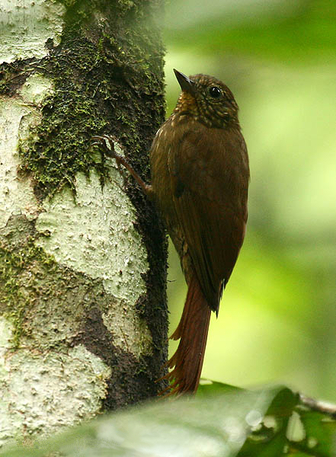Wedge-billed Woodcreeper
The Wedge-billed Woodcreeper , is a passerine bird which breeds in the tropical New World from southern Mexico to northern Bolivia, central Brazil and the Guianas; it is absent from the Pacific coastal areas except between Costa Rica and Ecuador. It is the only member of the genus Glyphorynchus.

Original source: Michael WoodruffPermission(Reusing this file)This image, which was originally posted to Flickr.com, was uploaded to Commons using Flickr upload bot on 23:56, 12 November 2008 (UTC) by Snowmanradio (talk). On that date it was licensed under the license below. This file is licensed under the Creative Commons Attribution-Share Alike 2.0 Generic license.You are free:to share – to copy, distribute and transmit the work
Author: Michael WoodruffPermission(Reusing this file)This image, which was originally posted to Flickr.com, was uploaded to Commons using Flickr upload bot on 23:56, 12 November 2008 (UTC) by Snowmanradio (talk). On that date it was licensed under the license below. This file is licensed under the Creative Commons Attribution-Share Alike 2.0 Generic license.You are free:to share – to copy, distribute and transmit the work
The Wedge-billed Woodcreeper is classified as Least Concern. Does not qualify for a more at risk category. Widespread and abundant taxa are included in this category.
The Wedge-billed Woodcreeper (Glyphorynchus spirurus), is a passerine bird which breeds in the tropical New World from southern Mexico to northern Bolivia, central Brazil and the Guianas; it is absent from the Pacific coastal areas except between Costa Rica and Ecuador. It is the only member of the genus Glyphorynchus. It is easily distinguished from its relatives by its small size and distinctive bill. The Wedge-billed Woodcreeper is typically 14–15 cm long, and weighs 14–16.5 g. More
the Wedge-billed Woodcreeper is the smallest species in the subfamily The woodcreepers are generally fairly uniform in appearance. They range in size from 13 cm (the Wedge-billed Woodcreeper) to 35 cm in length (the Strong-billed Woodcreeper). Males tend to be slightly larger than females on average, but there is considerable overlap in size in most species. Pronounced sexual dimorphism in size and plumage is rare. Bill size and shape accounts for much of the variation between the species. More
Rezultati za: wedge-billed woodcreeperPrijevodi 1 - 30 of 363 Engleski Engleski Finski Finski wedge-billed woodcreeper pikkukipuaja, Glyphorynchus spirurus wedge-billed hummingbird kiilanokkakolibri, Schistes geoffroyi red-billed woodcreeper punanokkakipuaja, Hylexetastes perrotii wedge-billed wren-babbler kiilanokkatimali, Sphenocichla humei ivory-billed woodcreeper norsunluukipuaja, Xiphorhynchus flavigaster straight-billed woodcreeper tikkakipuaja, Xiphorhynchus picus long-billed woodcreeper More
Wedge-billed woodcreeper Birds in Suriname = - Wedge-billed woodcreeper Photo of a Wedge-billed Woodcreeper, made by John Mittermeier on the Sipaliwini savanna in 2006. Otte Ottema recorded a sound of the Wedge-billed woodcreeper near the Coesewijne in May 2005. More
The Wedge-Billed Woodcreeper with its bill formation will be able to find a little more spider and insect prey in its native Mexico, Bolivia, and Brazil. Moist arboreal scrub with insect life will support the Woodcreeper. Woodcreepers take their name from their canopy adventures capturing prey and social behavior. However, Woodcreepers often flock attack ant swarms, the avian bill pecking deep into tree crevices to extract larvae or other insectivore prey. Woodcreepers are protective of trees and old growth for serious reasons. More
Family : Dendrocolaptidae
Genus : Glyphorynchus
Species : spirurus
Authority : (Vieillot, 1819)
